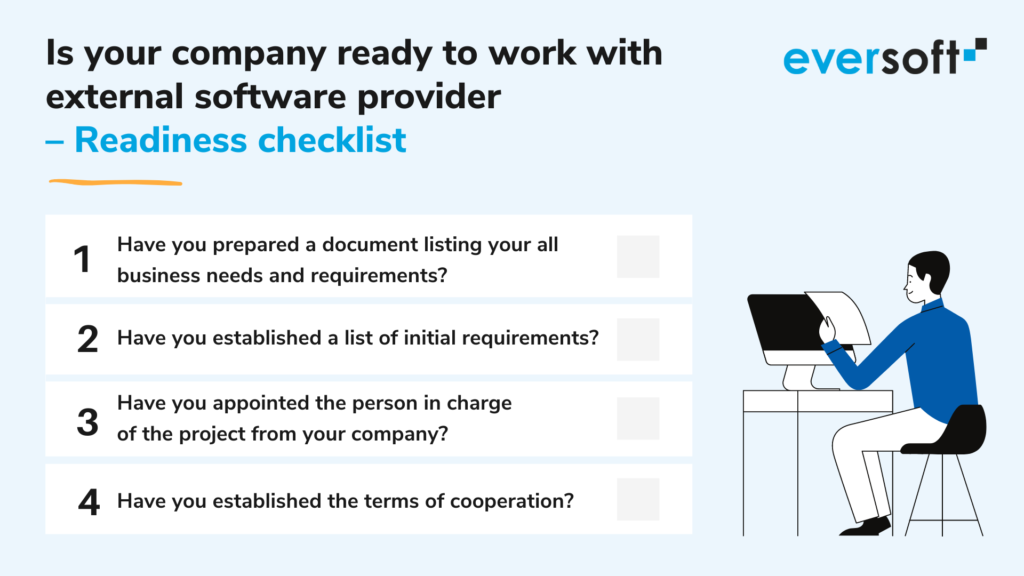Is your company ready to work with external software provider – Readiness checklist
Innovations in startups are mainly driven by the software that enhances business ideas. But there are some challenges during development – just turning an idea into MVP is not an easy task, not to mention ongoing development. It all requires experts with skills and experience in designing, developing, testing, deploying, and maintaining software projects. However, building an in-house team from scratch to make it all work (especially if you haven’t done it before) poses some serious threats.
The rest of the article is available below free e-book form

In this scenario, there is a high risk of making some bad technology-related decisions that can affect further software development and hinder the process of scaling it up. If it all sounds like too much hassle you should consider working with an external software house. By partnering with the right third-party software provider, you can expect a quality product with a minimal risk of project failure. To make sure you are ready to cooperate, take some time, take some time to address the 4 questions below:
Is your company ready to work with external software providers?
Table of contents:
- Have you prepared a document listing your all business needs and requirements?
- Have you established a list of initial requirements?
- Have you appointed the person in charge of the project from your company?
- Have you established the terms of cooperation?
- Readiness checklist completed? Start browsing for the right partner
1. Have you prepared a document listing your all business needs and requirements?
First, you need a product vision document that describes your company’s background, the business aim of the project and outlines the high-level business benefits. By establishing non-functional requirements, which are to be specified later on, the document allows you to set the right priorities. Of course, it does not imply that the strategy cannot be modified as the business environment changes over time.
However, if the document is frequently updated, it is easy to keep a tight grip on the project, allowing you to move resources where needed or to change priorities. The document needs to be written in simple language and then distributed to everybody within the team including sponsors and your dev team (i.e. testers, analysts, and programmers).
2. Have you established a list of initial requirements?
A list of requirements defines all functional and non-functional specifications regarding the software. The document will act as an essential guide and must include all capabilities, attributes, and qualities that are intended to be a part of the final version of the project.
Establishing a list at the very early stages is essential, making the difference between success and failure, especially when it comes to complex projects. The document also allows you to make informed choices when defining priorities. Requirements do not have to be very specific in the beginning – they will be specified when executed.
3. Have you appointed the person in charge of the project from your company?
When cooperating with an external software house you must also appoint an internal staff member to manage the project. The person who we refer to as a “Project Manager” or “Sponsor” is critical to the success or failure of the project. They have the right to change priorities, and to add or cancel requirements. He or she is also in charge of accepting the software provided by the third party company.
4. Have you established the terms of cooperation?
Contracts are typically agreed on either fixed-price or a time-and-materials basis. A fixed-price contract obliges the supplier to deliver the documented project within the agreed timeframe and quality requirements for a certain predefined total cost. On the other hand, the time-and-materials contract usually gives an estimate of the total costs but charged according to the actual hours worked.
Furthermore, the method of development has to be established: depending on the type of project, one has to choose between Agile (Scrum) or Waterfall methodologies – or one of the many other options available. It is also worth taking some time to define your preferred way of communication and your level of engagement in the project.

Readiness checklist completed? Start browsing for the right partner
Regardless of whether you are a startup or a scale-up, you must answer all 4 of these questions to ensure you are ready to cooperate with an external software provider. Once you establish the general vision of the product and general terms of cooperation, you will be able to find the right partner – as well as a quality product, you can also expect to benefit from knowledge on development, deployment, and maintenance of your future software.
Related posts:
- The biggest startups concern: How to organize a software development model when the product is constantly changing
-
9 code quality sins made by startups in their software development process




